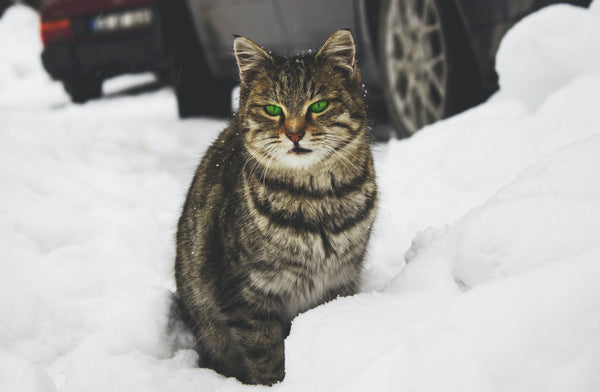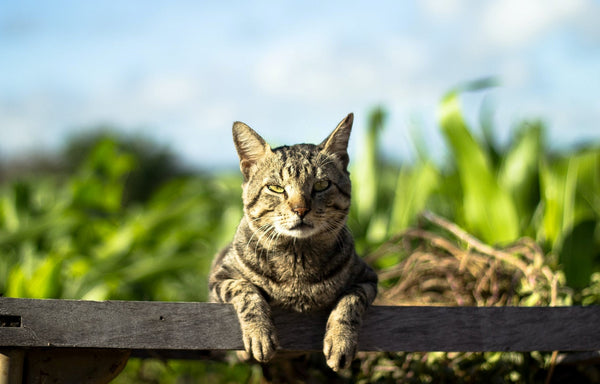
Everyone knows that dogs need daily walks. If you don't walk your dog, you're going to have many messes in your house. But cats? People typically view cats as much lower maintenance pets that don't require their owners to walk them. If they go outside, it's to run and play independently, not have their owners around. However, much to the surprise of cat owners, there are benefits to walking your cat!
There are many benefits of owning a pet and cats are no exception. Here are five benefits of walking your cat. We'll also go over (briefly) training your cat for a walk and tips for walking your cats more effectively.
Reason #1: Walking Your Cat Will Make Them Happier

One of the greatest tragedies of a modern cat's life is that they love the outdoors so much, yet they are safer indoors. They are so much safer, in fact, that the average life expectancy of an indoor cat is 17 years, while an outdoor one is five years at best.
The environment is a big factor in determining the average lifespan of a cat. There are just so many dangers for cats once they get out of the house that it is, unfortunately, very challenging to keep them alive for as many years.
However, cats in the wild live outdoors, and they don't like our elaborate houses as much as they love getting out there, chasing birds and mice.
Walking your cat gives your feline companion the best of both worlds. You are there to monitor their safety, and they get to explore the outdoors - safely. It improves their mental state while not reducing their life expectancy.
Reason #2: It's Fun!

Unlike dogs, cats don't require daily walks, and they don't need to go out during off times of the day or night. So, you can take them outside to walk them on your terms, which, honestly, makes it incredibly fun! Taking your furry feline friend to the coffee shop with you makes the experience that much more enjoyable. It's like having a dog's companionship, without the burden of needing to walk it regularly, which is fantastic.
Reason #3: It Makes Your Cat Healthier

59.5% of cats are obese in the United States. As with humans, obesity in cats causes numerous health issues, including diabetes, heart problems, and joint problems as they get older.
Unfortunately, with the way that modern cats live, it's incredibly easy for them to become overweight. Thus, it's important for you to learn how to help your cat lose weight.
They have plenty of access to tasty unhealthy food (typically, common, lower-cost foods are worse for a cat's health than higher-priced nutritious ones) unlike indoor cats who often get the best food for feline nutrition. Furthermore, indoor cats can only get so much exercise. It's much different when your feline friend is outdoors looking for prey instead of snuggling up on the sofa with their owner.
Walking your cat enables them to be healthier without risking their lives in other ways (e.g., by them accidentally getting hit by a car). The exercise that they get from walking will help build muscle mass, burn fat, and make their bodies more resilient to disease, diabetes, and heart problems.
Reason #4: Walking Your Cat Boosts Their Confidence

Walking your cat outside can boost their confidence and give them a better sense of what's out there. Under your watchful eye, they'll learn where they can and cannot go, what they can and cannot eat, and so forth. While cats don't have quite the same mental capacity as dogs do for training, they can pick up on things from their owners while out for a walk. Cats are actually smarter than we give them credit for.
Furthermore, if your cat accidentally escapes your house, the walk will give them confidence that they can find their way around and back home. If you never take your cat outside, they'll never learn where their home is!
Reason #5: It's Natural

While the harness and leash are not natural for a cat to have, walking outdoors most certainly is. Allowing your cat to be themselves in the outdoors is excellent for your pet's mental health and sanity. It helps keep your cat's cognitive abilities high. Your pet will see real trees, instead of scratching posts, and actual rodents and prey, instead of catnip toys. Putting your cat in their natural environment is always a positive thing!
Training Your Cat for a Walk

It's relatively straightforward when it comes to training your cat for a walk. Put the harness on your cat inside the house and let them get used to it. As they're learning about the leash, you can get a sense of how to help your cat navigate the floors around your home. Once they have the hang of that, it's time to go out for a real walk! Sometimes it can take multiple tries to get the walking part right, so don't despair!
A Couple Tips for Walking Your Cats

Walking your cat is straightforward, for the most part. However, there are a couple of tips that will help get you started.
- Don't buy a dog leash or harness! Cats are not like dogs and cannot have the neck leashes. Instead, look for a body harness for your cat so that when you pull the leash and try to get your feline friend to retreat, the force spreads evenly across the chest area.
- Keep your cat close. If you let your cat wander too much, and get away from you, it will be no different from allowing your cat outside in the beginning.
Walking Your Cat Is Not Difficult

While walking your cat might be less popular than walking a dog, it still has many beneficial aspects for your feline and can even improve your cat's longevity. It can boost their mental and physical health, so you should consider starting doing so with your furry companion.




